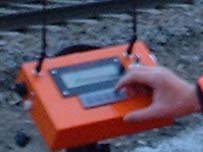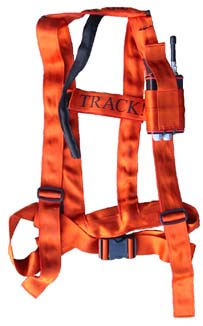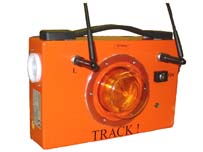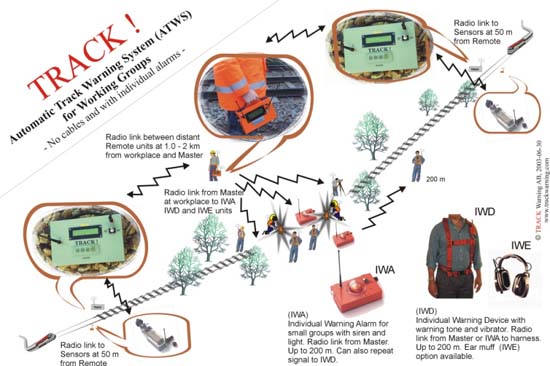TRACK! 02 ATWS Needs to be in Constant Use
21 Jun 2004
 Colin Wheeler Reports:
Colin Wheeler Reports:
Infrequent use of TRACK Warning (UK) Ltd’s automatic track warning system has emerged as one of the main reasons for incidents and irregularities, which have occurred whilst it is being used.
What happened at Keynsham?
Following an incident at Keynsham near Bristol on March 18th, Network Rail imposed restrictions on the use of Track!02 in bi-directional working situations. Carillion decided to stop using the equipment until the results of a Network Rail inquiry were known.
At Keynsham an approaching train was detected. The work group received the warning and moved to the designated place of safety. The operator, following current instructions left the alarm sounding. But the train then stopped in the station. Meanwhile a second train entered the section protected by the ATWS and was apparently not separately detected by the still sounding equipment.
Working less safely
At the AOTLS Annual General Meeting held at Stonebridge on May 11th, some members were vociferous in voicing their concerns. A number have bought sets of Track!02, following encouragement from Network Rail to equip themselves with automatic track warning systems.
TES 2000 and Bridgeway pointed out that they were amongst the companies who had between them bought over a hundred sets of the best selling ATWS available.
They had done so in the knowledge that both Network Rail and Her Majesty’s Railway Inspectorate had approved the kit. They also drew attention to the fact that, as a result, they are now having to work less safely using lookouts whilst their ATWS equipment lies on the shelf.
Continue to blow your horn?

Track!02 was designed to give warning of approaching trains, with the warning being manually cancelled by a trained operator. But Network Rail preferred operating instructions, which mandate that the warnings continue until after the train has cleared the work site.
Of course, we never ask a lookout to continue blowing his horn or whistle after everyone has reached a position of safety. If Peewee is used, a rare event these days, the warning is stopped as soon as everyone is clear. Indeed I recall track staff complaining that TOWS (train operated warning systems) go on and on, especially when you are standing in the position of safety, waiting for what turns out to be a slow freight train!
The other ATWS systems currently work like TOWS, so there is no case for mandating either situation. Track staff are already used to getting both warnings, which stop when they are in a safe position, and warnings, which continue until the train has passed.
Over 30 pages of Investigator’s Report
One of Network Rail’s National Investigators has produced a draft report which I understand runs to over 30 pages. It reviews not only Keynsham but also other incidents, which occurred as long ago as August 2002.
The main findings of the investigation, I understand, are centred on the training, continuing competence and suitability of the operators.
To become a Track!02 operator you must first hold the Sentinel registered competency of COSS (Controller of Site Safety). A two-day training course, mentored use of the equipment and the passing of an examination are then mandated before you are fully trained.
After a period of mentoring a further examination has to be passed before accreditation. Current documentation also specifies that non use of the competence for a period of more than nine months will lead to the accreditation being withdrawn.
It is now suggested that nine months is too long, I agree. Indeed, the most productive and safest situation would be for the equipment to be in constant use with the operator using it all the time. I see this being recognised at last. Unlike Peewee, ATWS is a complex, although very safe piece of equipment.
Demands on the Operators

Tellingly, the Investigator has drawn attention to the competency demands made of operators and the detailed operating instructions and the professionalism of the COSS’s who are selected for operator training. I know of situations, which have led to operators being described as “inexperienced and confused”.
It has been suggested that the selection of operators needs to specify ability levels greater than those needed for normal track maintenance activities. (I would rather say different than greater, since I believe that after 37 years working on track I appreciate just how skilled a good track maintenance tradesman needs to be.)
However, I fear the idea that looking out is a job for the least skilled or fit person in the gang, still persists. This may be debatable but the idea that an ATWS operator be selected in the same way is indisputably wrong.
Confidence not Safe tone
The Investigator writes that the equipment is based on simple but sound technology and defaults to a safe condition. He also reports on the comprehensive operating instructions and is complimentary about them, saying that they provide “guidance in everyday language that can be understood by operators.”
Checklists are provided for them to use, and this he also commends. His report draws attention to the fact that the operator can override a default situation and this appears to be one of his concerns.
Recommendations are likely to include interim changes to the instructions. Operators will undergo further training and will in future cancel warnings as soon as the work group have all reached the place of safety. The intermittent sound/vibration described as the “safe tone” will be redesignated as the “confidence tone”, which is a more accurate description.
Back on track in July
The investigation also identified the possibility of false warnings being generated by the acceleration or braking of heavy freight trains. Apparently the vibrations so caused could cause spurious warnings to be given.
To cover this possibility, it is likely that an exclusion area for the siting of the detectors, which are activated by vibration, of 400 metres will be imposed. At present the operator can set the system up and then work with the gang, this practice is also being looked at. Hopefully by the beginning of July we will start to see Track!02 in use again on our railway.
Network Rail are also known to be working with Track Warning (UK) Ltd on a potential software upgrade which would ensure that, even if the warning was sounding from a first train, when a second train entered the protected area, a further warning would be generated.
Three hundred thousand times safer
I regret the time taken to reach this situation, but appreciate what has been done so far. The sooner the kit is back in use the better.
At the European Rail Research Institute Conference in Rome in 1996, it was established that whilst lookouts fail on one in 10,000 occasions, ATWS failure rates were somewhere between one in 100 million and one in 10,000 million. This latter figure was refined to one in 3,000 million.
To put it simply, so that I understand it, ATWS is recognised throughout Europe as being at least three hundred thousand times safer than working with a lookout. No wonder some European countries have already decided to stop using lookouts altogether!
Railway Inspectorate should help
But surely the Railway Inspectorate should help rather than just watch what is going on? One of their Inspector’s has described their role as “letting the industry find its own solution to the problems identified by the Red/Green Zone report rather than imposing a prescriptive view.”
He does acknowledge that the industry “has some way to go before achieving compliance with its RIMINI standard.” But he explains that Her Majesty’s Railway Inspectorate is “concentrating on checking how well the industry is meeting the standards it has set.”
The red/green zone report is now several years old; will we ever reach a point when the Inspectorate, or their successors, say enough is enough and take the lead?
European Operating Instructions?
Whilst Track!02 was first approved by Spain, its approval by Britain was relatively early. Other ATWS systems were developed to meet market demand in their countries of origin.
Operating instructions should surely be basically the same across all European countries? The increased membership of the European Union should lead to lower costs; but it will not do so if member states, including Britain, insist that they must be regarded as unique.
European Type Approvals
The same applies to the type approval of equipment. I was appalled when shown a complete library of separate safety cases for a single piece of kit, all different to suit different European requirements.
The effects are not just commercial. Companies are deciding not to progress the development of equipment which could benefit us all simply because of the anticipated multi-state approval costs!

Return to News Home Page
 Colin Wheeler Reports:
Colin Wheeler Reports: Track!02 was designed to give warning of approaching trains, with the warning being manually cancelled by a trained operator. But Network Rail preferred operating instructions, which mandate that the warnings continue until after the train has cleared the work site.
Track!02 was designed to give warning of approaching trains, with the warning being manually cancelled by a trained operator. But Network Rail preferred operating instructions, which mandate that the warnings continue until after the train has cleared the work site.
 Tellingly, the Investigator has drawn attention to the competency demands made of operators and the detailed operating instructions and the professionalism of the COSS’s who are selected for operator training. I know of situations, which have led to operators being described as “inexperienced and confused”.
Tellingly, the Investigator has drawn attention to the competency demands made of operators and the detailed operating instructions and the professionalism of the COSS’s who are selected for operator training. I know of situations, which have led to operators being described as “inexperienced and confused”.

